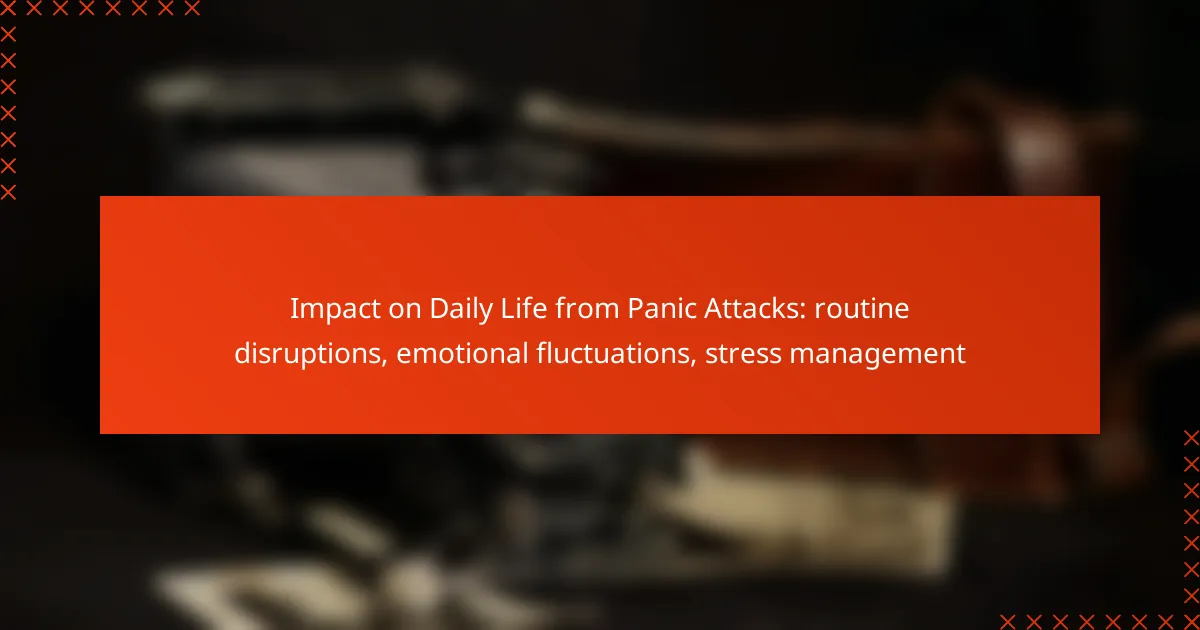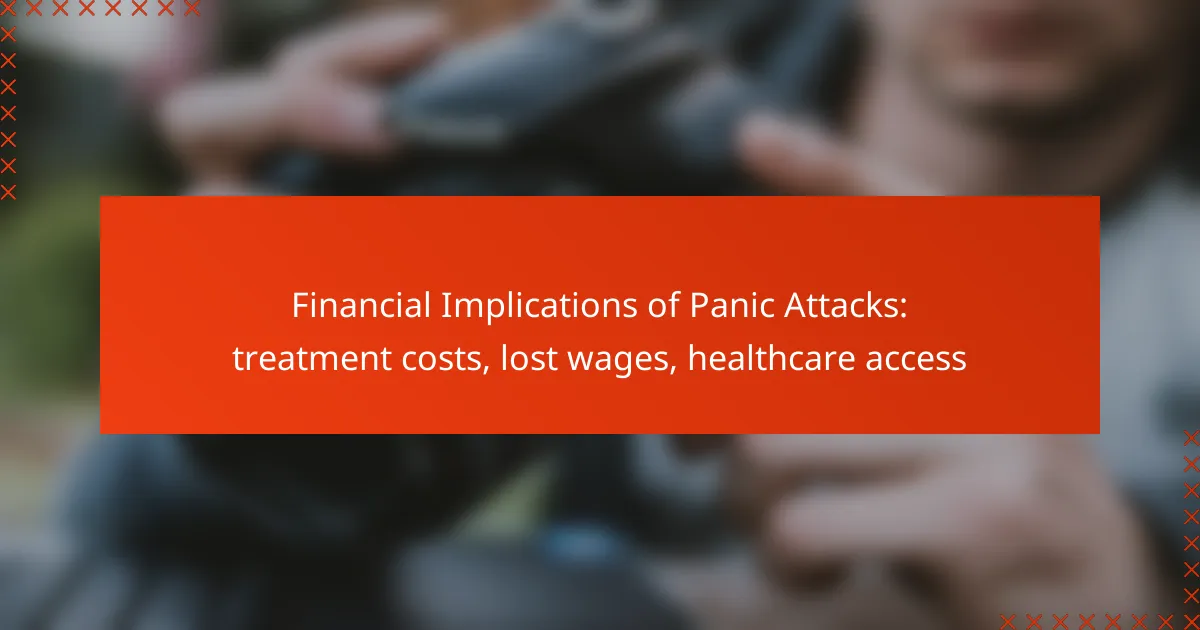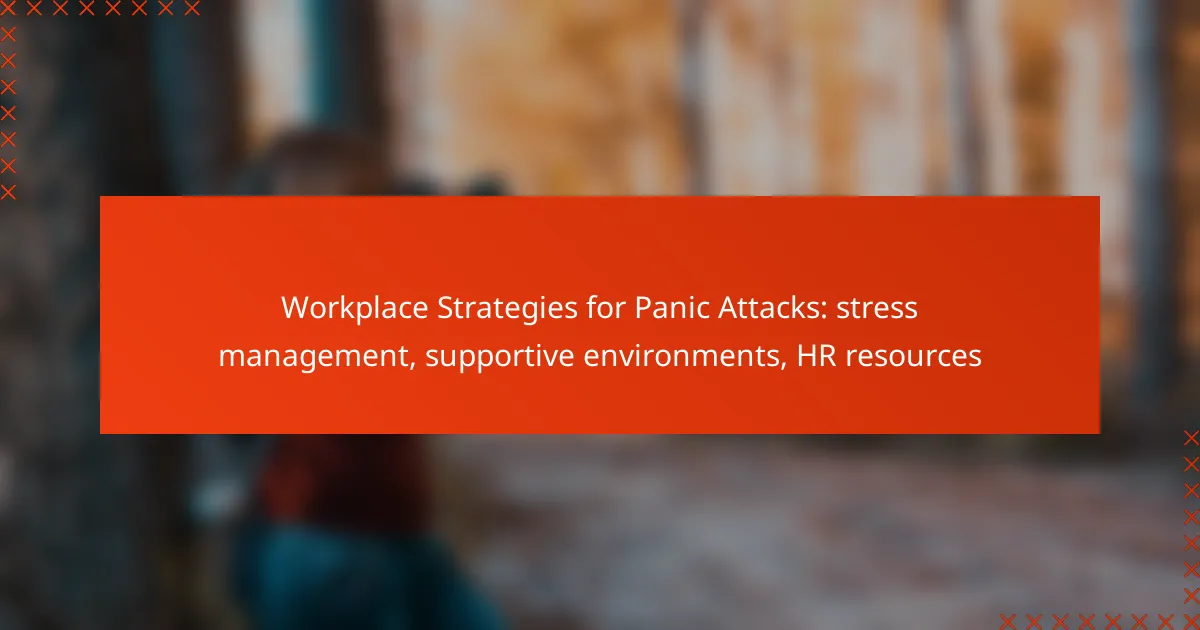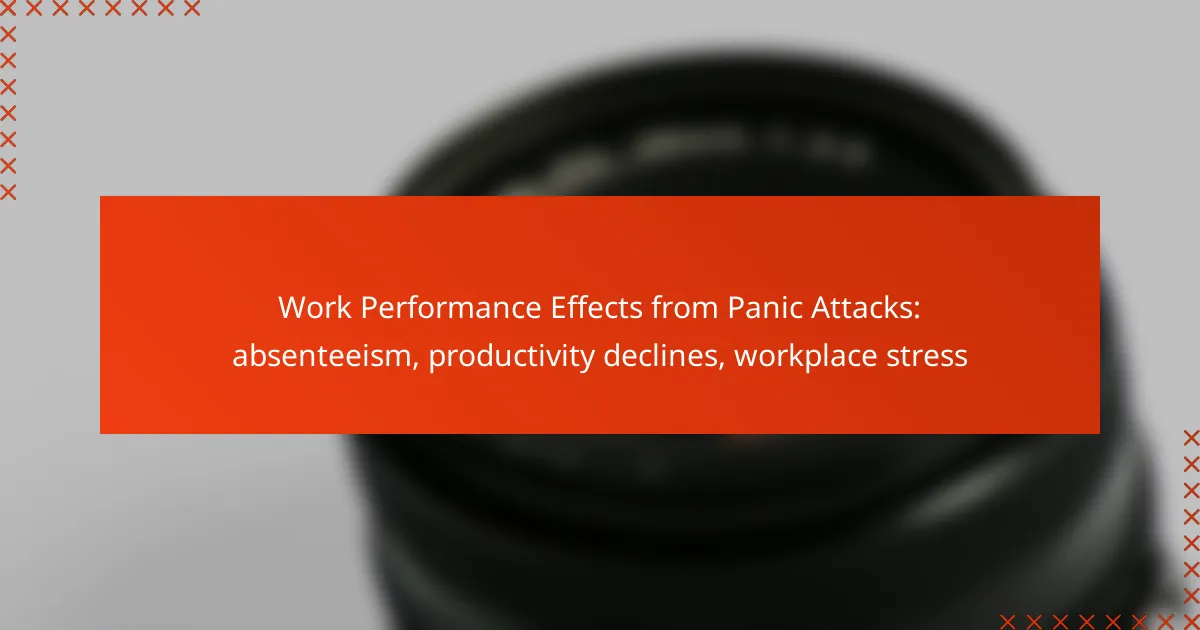Panic attacks can profoundly disrupt daily life by triggering sudden episodes of intense fear and discomfort, which often result in emotional fluctuations and heightened stress. These challenges can make it difficult to manage everyday responsibilities and maintain a stable routine. Implementing effective stress management techniques can help individuals regain control, reduce the frequency of attacks, and enhance overall well-being.
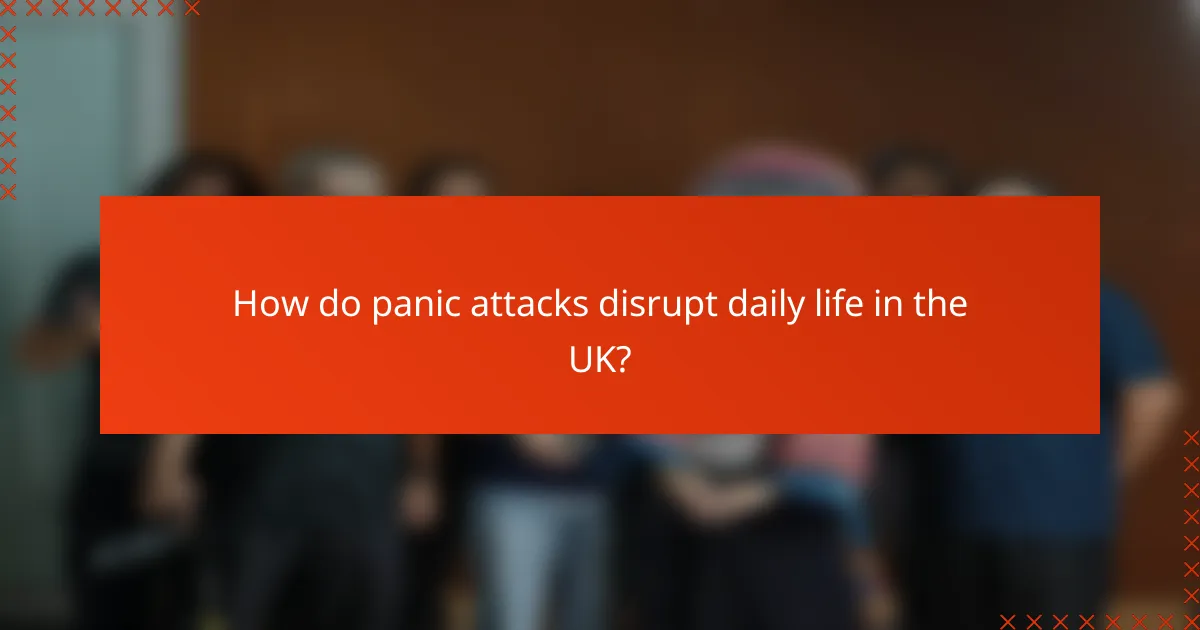
How do panic attacks disrupt daily life in the UK?
Panic attacks can significantly disrupt daily life in the UK by causing sudden episodes of intense fear or discomfort. These episodes often lead to emotional fluctuations, increased stress, and challenges in managing everyday responsibilities.
Impact on work productivity
Panic attacks can severely hinder work productivity by causing individuals to miss workdays or struggle to focus during tasks. The fear of experiencing an attack in the workplace may lead to avoidance of certain situations, such as meetings or presentations.
Employers in the UK are encouraged to provide support for employees experiencing mental health issues, including panic attacks. Flexible working arrangements or access to mental health resources can help mitigate these productivity losses.
Effects on social interactions
Panic attacks can create barriers to social interactions, making individuals feel isolated or anxious in social settings. The fear of having an attack in public can lead to avoidance of gatherings, which may strain friendships and family relationships.
To manage these effects, individuals can gradually expose themselves to social situations while employing coping strategies, such as deep breathing or mindfulness techniques, to reduce anxiety.
Influence on daily routines
Daily routines can be significantly affected by panic attacks, as individuals may alter their schedules to avoid triggers. This can include avoiding crowded places or limiting travel, which can disrupt normal activities such as shopping or commuting.
Establishing a consistent routine that incorporates relaxation techniques can help individuals regain a sense of control and reduce the frequency of panic attacks.
Challenges in personal relationships
Panic attacks can pose challenges in personal relationships, as partners or family members may struggle to understand the condition. This lack of understanding can lead to frustration or feelings of helplessness on both sides.
Open communication about the nature of panic attacks and their impact can foster empathy and support. Couples or family therapy may also be beneficial in navigating these challenges and strengthening relationships.

What emotional fluctuations are caused by panic attacks?
Panic attacks can lead to significant emotional fluctuations, impacting a person’s overall mental health. These fluctuations often manifest as heightened anxiety, feelings of isolation, and instability in mood, which can disrupt daily life and routines.
Increased anxiety levels
During and after a panic attack, individuals frequently experience elevated anxiety levels. This heightened state of anxiety can persist, making it challenging to engage in everyday activities. For instance, someone may feel anxious about leaving their home or being in crowded places, fearing another attack might occur.
To manage increased anxiety, consider practicing mindfulness techniques or engaging in regular physical exercise. Both methods can help reduce overall anxiety and improve coping mechanisms.
Feelings of isolation
Panic attacks can lead to feelings of isolation, as individuals may withdraw from social situations due to fear of experiencing an attack in public. This withdrawal can create a cycle where the lack of social interaction exacerbates feelings of loneliness and depression.
To combat isolation, it’s important to maintain connections with friends and family. Setting small, achievable social goals, like attending a gathering for a short period, can help gradually reduce feelings of isolation.
Impact on mood stability
The emotional aftermath of panic attacks often includes mood instability, where individuals may swing between feelings of sadness, irritability, and anxiety. This instability can affect relationships and work performance, making it difficult to maintain a consistent emotional state.
To improve mood stability, establishing a routine that includes regular sleep, balanced nutrition, and stress-reducing activities can be beneficial. Keeping a mood journal may also help track triggers and patterns, allowing for better management of emotional responses.

How can stress management techniques help?
Stress management techniques can significantly reduce the frequency and intensity of panic attacks by promoting relaxation and emotional stability. These methods help individuals regain control over their responses to stressors, leading to improved daily functioning and overall well-being.
Mindfulness practices
Mindfulness practices involve focusing on the present moment without judgment, which can help mitigate anxiety and panic. Techniques such as meditation, body scanning, and mindful breathing encourage awareness of thoughts and feelings, allowing individuals to observe their panic symptoms without becoming overwhelmed.
Incorporating mindfulness into daily routines can be simple. For instance, setting aside just 5-10 minutes each day for mindfulness meditation can create a calming effect that persists throughout the day. Apps like Headspace or Calm can provide guided sessions for beginners.
Cognitive-behavioral therapy
Cognitive-behavioral therapy (CBT) is a structured approach that helps individuals identify and change negative thought patterns contributing to panic attacks. By challenging irrational beliefs and replacing them with more balanced thoughts, CBT can reduce anxiety and improve coping strategies.
Typically, CBT involves weekly sessions over several months, focusing on practical skills such as exposure therapy and cognitive restructuring. Many therapists offer sliding scale fees, making this effective treatment accessible to a broader range of individuals.
Breathing exercises
Breathing exercises are effective tools for managing panic attacks by promoting relaxation and reducing physiological symptoms of anxiety. Techniques such as diaphragmatic breathing or the 4-7-8 method can help slow the heart rate and lower blood pressure during a panic episode.
To practice diaphragmatic breathing, sit comfortably and inhale deeply through the nose for a count of four, hold for a count of four, and exhale slowly through the mouth for a count of six. Regular practice, even for a few minutes each day, can enhance resilience against stress and panic.

What role do medications play in managing panic attacks?
Medications can be an effective tool for managing panic attacks by reducing their frequency and intensity. They work by balancing neurotransmitters in the brain, which can help alleviate anxiety symptoms associated with panic disorders.
Common medications prescribed
Common medications for panic attacks include selective serotonin reuptake inhibitors (SSRIs) like fluoxetine and sertraline, as well as benzodiazepines such as lorazepam and alprazolam. SSRIs are often preferred for long-term management due to their lower risk of dependence.
Other options may include serotonin-norepinephrine reuptake inhibitors (SNRIs) like venlafaxine, which can also be effective. It’s essential to consult a healthcare provider to determine the best medication based on individual symptoms and medical history.
Side effects and considerations
Medications for panic attacks can have side effects, including drowsiness, dizziness, and gastrointestinal issues. Benzodiazepines, while effective for short-term relief, carry a risk of dependence and withdrawal symptoms if used long-term.
Patients should discuss potential side effects with their healthcare provider and consider lifestyle changes or therapy as complementary approaches. Regular follow-ups can help monitor effectiveness and adjust dosages as needed.
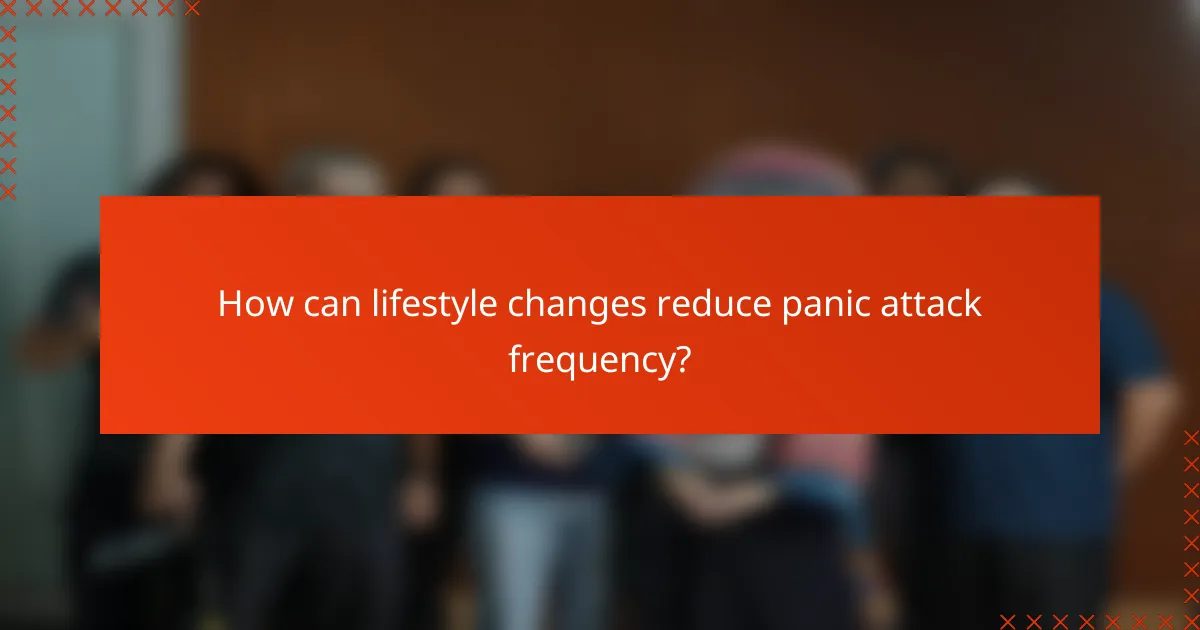
How can lifestyle changes reduce panic attack frequency?
Lifestyle changes can significantly lower the frequency of panic attacks by promoting overall mental well-being and reducing stress. Incorporating regular exercise, maintaining good sleep hygiene, and focusing on nutrition are effective strategies for managing anxiety and panic symptoms.
Regular exercise benefits
Engaging in regular exercise can help reduce the frequency of panic attacks by releasing endorphins, which act as natural stress relievers. Aim for at least 150 minutes of moderate aerobic activity each week, such as brisk walking or cycling, to experience these benefits.
In addition to aerobic exercise, incorporating strength training and flexibility exercises can enhance overall physical health and resilience against stress. Activities like yoga and tai chi also promote relaxation and mindfulness, further aiding in panic attack management.
Importance of sleep hygiene
Good sleep hygiene is crucial for mental health and can help prevent panic attacks. Establishing a consistent sleep schedule, creating a relaxing bedtime routine, and ensuring a comfortable sleep environment can improve sleep quality.
Aim for 7-9 hours of sleep per night. Avoid stimulants like caffeine and electronic devices before bedtime, as they can disrupt sleep patterns and contribute to anxiety, increasing the likelihood of panic attacks.
Nutrition’s impact on mental health
Nutrition plays a vital role in mental health, influencing mood and anxiety levels. A balanced diet rich in whole foods, including fruits, vegetables, whole grains, and lean proteins, can support brain function and emotional stability.
Consider limiting processed foods, sugar, and caffeine, as these can exacerbate anxiety symptoms. Staying hydrated and incorporating omega-3 fatty acids, found in fish and flaxseeds, may also contribute to better mental health and reduced panic attack frequency.

What support systems are available for individuals experiencing panic attacks?
Individuals experiencing panic attacks can access various support systems designed to help manage symptoms and improve overall well-being. These systems include professional therapy, medication, and community support groups that provide shared experiences and coping strategies.
Support groups in the UK
Support groups in the UK offer a safe space for individuals dealing with panic attacks to share their experiences and learn from one another. These groups often meet regularly and can be found in various formats, including in-person and online sessions.
Many organizations, such as Anxiety UK and the National Health Service (NHS), provide resources and facilitate support groups. Participants can benefit from the collective wisdom of others who understand their struggles, which can foster a sense of belonging and reduce feelings of isolation.
When considering joining a support group, look for those that are led by trained facilitators who can guide discussions and ensure a supportive environment. It’s also helpful to check the frequency of meetings and the group size to find a setting that feels comfortable for you.
